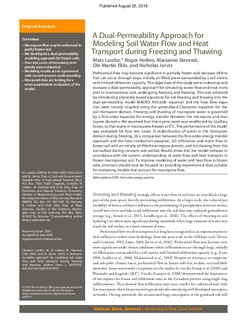| dc.contributor.author | Larsbo, Mats | |
| dc.contributor.author | Holten, Roger | |
| dc.contributor.author | Stenrød, Marianne | |
| dc.contributor.author | Eklo, Ole Martin | |
| dc.contributor.author | Jarvis, Nicholas | |
| dc.date.accessioned | 2020-01-13T09:53:50Z | |
| dc.date.available | 2020-01-13T09:53:50Z | |
| dc.date.created | 2019-09-13T13:34:59Z | |
| dc.date.issued | 2019-08-22 | |
| dc.identifier.citation | Vadose Zone Journal. 2019, 18 (1), . | nb_NO |
| dc.identifier.issn | 1539-1663 | |
| dc.identifier.uri | http://hdl.handle.net/11250/2635885 | |
| dc.description.abstract | Preferential flow may become significant in partially frozen soils because infiltration can occur through large, initially air-filled pores surrounded by a soil matrix with limited infiltration capacity. The objectives of this study were to develop and evaluate a dual-permeability approach for simulating water flow and heat transport in macroporous soils undergoing freezing and thawing. This was achieved by introducing physically based equations for soil freezing and thawing into the dual-permeability model MACRO. Richards’ equation and the heat flow equation were loosely coupled using the generalized Clapeyron equation for the soil micropore domain. Freezing and thawing of macropore water is governed by a first-order equation for energy transfer between the micropore and macropore domains. We assumed that macropore water was unaffected by capillary forces, so that water in macropores freezes at 0°C. The performance of the model was evaluated for four test cases: (i) redistribution of water in the micropore domain during freezing, (ii) a comparison between the first-order energy transfer approach and the heat conduction equation, (iii) infiltration and water flow in frozen soil with an initially air-filled macropore domain, and (iv) thawing from the soil surface during constant-rate rainfall. Results show that the model behaves in accordance with the current understanding of water flow and heat transport in frozen macroporous soil. To improve modeling of water and heat flow in frozen soils, attention should now be focused on providing experimental data suitable for evaluating models that account for macropore flow. | nb_NO |
| dc.language.iso | eng | nb_NO |
| dc.relation.uri | https://dl.sciencesocieties.org/publications/vzj/articles/18/1/190012 | |
| dc.rights | Attribution-NonCommercial-NoDerivatives 4.0 Internasjonal | * |
| dc.rights.uri | http://creativecommons.org/licenses/by-nc-nd/4.0/deed.no | * |
| dc.title | A Dual-Permeability Approach for Modeling Soil Water Flow and Heat Transport during Freezing and Thawing | nb_NO |
| dc.type | Journal article | nb_NO |
| dc.type | Peer reviewed | nb_NO |
| dc.description.version | publishedVersion | nb_NO |
| dc.rights.holder | © 2019 The Author(s). | nb_NO |
| dc.subject.nsi | VDP::Landbruks- og Fiskerifag: 900 | nb_NO |
| dc.source.pagenumber | 11 | nb_NO |
| dc.source.volume | 18 | nb_NO |
| dc.source.journal | Vadose Zone Journal | nb_NO |
| dc.source.issue | 1 | nb_NO |
| dc.identifier.doi | 10.2136/vzj2019.01.0012 | |
| dc.identifier.cristin | 1724487 | |
| dc.relation.project | Norges forskningsråd: 244526 | nb_NO |
| cristin.unitcode | 7677,3,0,0 | |
| cristin.unitname | Divisjon for bioteknologi og plantehelse | |
| cristin.ispublished | true | |
| cristin.fulltext | original | |
| cristin.qualitycode | 1 | |

